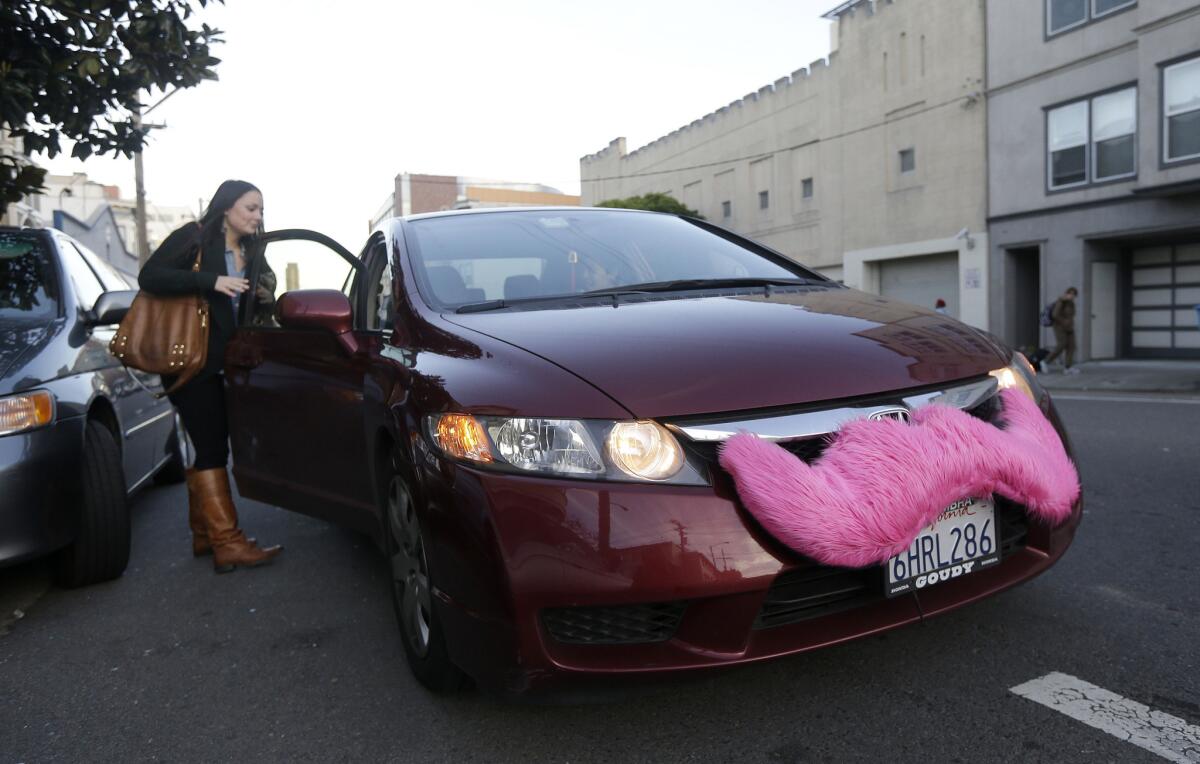Opinion: Putting a price tag on the risk posed by ride-sharing drivers

California Insurance Commissioner Dave Jones announced approval Wednesday of the first policy by a major insurer to offer coverage for drivers participating in ride-sharing services. Above, Lyft passenger Christina Shatzen gets into a car in San Francisco in 2013.
- Share via
Simply turning on a smartphone ride-sharing application, such as Uber or Lyft, makes a driver about 8% riskier on average.
That’s what Farmers Insurance estimates, at least. As my colleague Tracey Lien reported, Farmers is the first major insurer in California to offer a policy that explicitly covers drivers participating in a ride-sharing service while they’re waiting to be summoned by a passenger.
State Insurance Commissioner Dave Jones announced his department’s approval of Farmers’ new policy Wednesday. It will become available from Farmers agents Thursday, just days before new state insurance mandates for “transportation network companies” and their drivers go into effect.
Uber and Lyft say their commercial insurance policies cover accidents that occur from the time the driver accepts a request for a ride to the time the trip is finished. That leaves a gap in coverage during the times a driver is tooling around with the ride-sharing app on, waiting for a ride request. Most (if not all) personal auto policies won’t cover accidents involving drivers with an active ride-sharing app because they classify ride-sharing as a commercial activity.
The Farmers policy would cover ride-sharing drivers for an 8% surcharge over its normal rates for a personal auto policy. To win state approval for that premium, it had to show that it was justified by an increase in risk -- in other words, that it was reasonable to project that ride-sharing drivers will run up 8% more costs from collisions and injuries than their nonride-sharing counterparts.
With little or no history of claims to go by, Farmers’ projection amounts to an educated guess. By contrast, some ride-sharing executives have long argued that their drivers have a better safety record than the average motorist. But one of the risks for Farmers is “adverse selection” -- the possibility that the drivers with the worst safety records will be the first ones to sign up for policies.
That’s especially true when there aren’t a lot of options for coverage. According to Jones’ office, only one other insurer has filed a ride-sharing coverage plan for the state’s approval: Metromile, an upstart that offers UberX drivers coverage with premiums based on the number of miles driven.
The new state insurance mandate doesn’t require ride-sharing drivers to obtain policies like the ones Farmers and Metromile are offering. Instead, the requirement can be satisfied by the ride-sharing platform’s liability coverage.
Nevertheless, there’s a good reason for them to fork over the extra premium: the liability coverage carried by Uber, Lyft and their ilk won’t pay for damage to the driver’s own car, or injuries the driver suffers. Nor will they help if the driver is hit by an uninsured motorist.
That incentive is evidently enough to persuade Farmers to take the leap on policies for ride-sharing drivers. It could be a lucrative bet, considering the rapid growth in ride-sharing; according to the Insurance Department, Uber and Lyft alone have reported a nearly 130% increase in monthly usage compared with last year.
Spokespeople for Uber and Lyft said their comapnies would not require drivers to carry ride-sharing policies.
Follow Healey’s intermittent Twitter feed: @jcahealey
More to Read
A cure for the common opinion
Get thought-provoking perspectives with our weekly newsletter.
You may occasionally receive promotional content from the Los Angeles Times.







